Sustainability Leaders: Alison Grant, Senior Designer at HLW
In an illuminating interview with Alison Grant, Senior Designer at HLW, we delve into the dynamic world of sustainable design and its transformative potential. Alison’s career trajectory, from healthcare architecture to commercial workplace design, showcases her diverse expertise. In her role for HLW Alison leads internal project teams, fosters innovation, and mentors emerging talents while spearheading sustainability efforts.
Alison shares HLW’s ground-breaking Healthy Material Protocol, a game-changing resource championing healthy and sustainable building materials. Alison underscores the ripple effects of the Healthy Material Protocol, as clients, regardless of their initial inclinations, make environmentally responsible choices, aligning with the growing importance of ESG messaging in the post-COVID era. She passionately advocates for industry-wide adoption of sustainable material selection and calls on manufacturers to prioritize eco-friendly practices!
Enjoy our conversation!
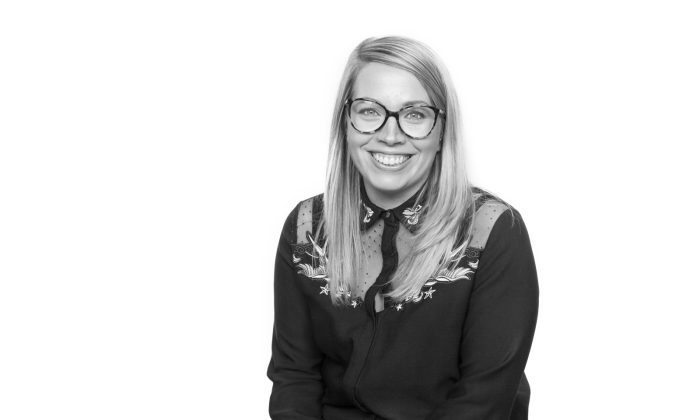
Alison Grant, Senior Designer at HLW
It is important to our readers to get to know the designers’ making waves in our sector and behind the projects we discuss, please could you tell me about yourself, your role and HLW?
After graduating from the University for the Creative Arts in 2007, I became an interior designer. First, I worked in healthcare architecture from a client side and then from the consultancy side before I moved to commercial workplace design. My role at HLW is Senior Designer so my job is to lead our internal project team to come up with creative solutions to meet our client’s needs. I encourage them to push the boundaries of design when it’s appropriate to do so whilst guiding and mentoring the younger members of our team to be the leaders of tomorrow. I also spend a lot of my time leading our Sustainability efforts locally in our London office. This includes speaking at events, participating in groups like the Sustainable Design Collective, and encouraging our team to make more sustainable design decisions whilst educating them in how to do this alongside our brilliant BEYOND team of sustainability analysts.
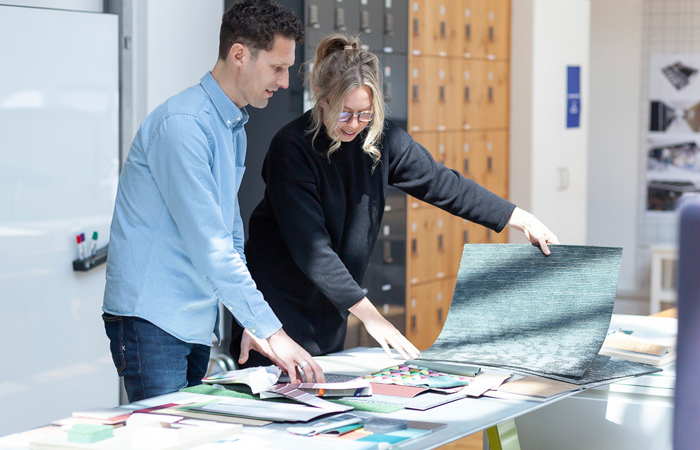
Materials Review, HLW, London
The mission at HLW is to question the norm, design with passion, and build what’s next! Could you talk me through a selection of your projects and how they align with this mission?
What I love about HLW is that our portfolio is so diverse, and no two projects look alike. For me building what’s next isn’t just about technology, BIM, and AI, but how we really build spaces that will allow everyone to have parity of experience and continue to be able to flex and adapt that experience over time. I have been lucky enough to spend the last 6 years working very closely with one of the biggest global tech giants on various projects. They are a very progressive client in terms of accessibility and inclusivity in design, which means we must think outside the box to ensure we are truly accommodating everyone within the space. They also have a unique aesthetic which is driven by functional design and best-in-class material health. These projects look visually very different from the rest of our portfolio and are a masterclass in how to not have an ego when designing. Designing for people is more humbling and important than designing for aesthetics alone, but that’s not to say these spaces don’t end up being showstopping! On the other end of the spectrum, we have clients who expect a very high-end experience with intricate detailing, luxury material selection, and considerations into sensory experiences beyond sight and touch.
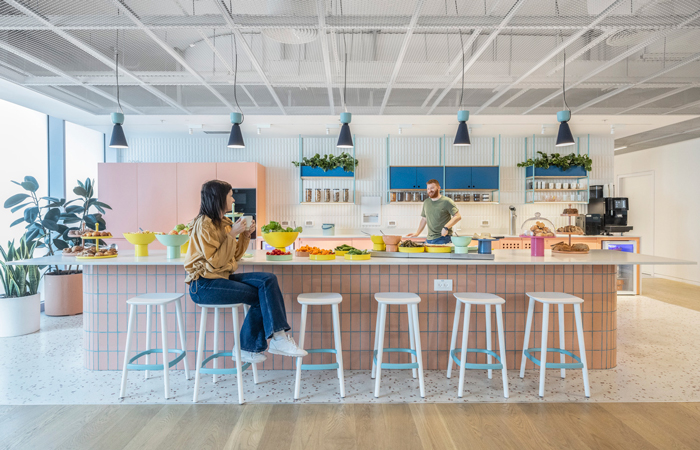
HLW, Wix Tel Aviv Campus ©Alan Tzatzkin
In order to meet HLW’s commitment to the Architecture 2030 Challenge, to achieve ambitious energy reduction targets and being carbon neutral by 2030, HLW developed a Sustainability Action Plan. Could you talk me through the framework this has provided for you to create innovative and sustainable solutions?
The Sustainability Action Plan (SAP) has given us a robust process for achieving actionable sustainability goals across our project work and at our firm. Internally, we have developed an education program to inform and deepen our staff’s sustainability knowledge across all levels. The healthy materials protocol was created and implemented with the support of our SAP. We’ve also established a methodology and target baselines to measure and reduce our energy, water, waste, and carbon in all our offices. This embedded sustainability thinking carries through to our project work as well. We integrate sustainability from the onset of a project, establishing goals that also align with our client’s goals to ensure greater success. Utilizing early design sustainability analysis tools allows us to identify opportunities and challenges from the start. We leverage our rating system expertise to decide on the optimal rating systems or can develop custom sustainability frameworks to maximize impact.
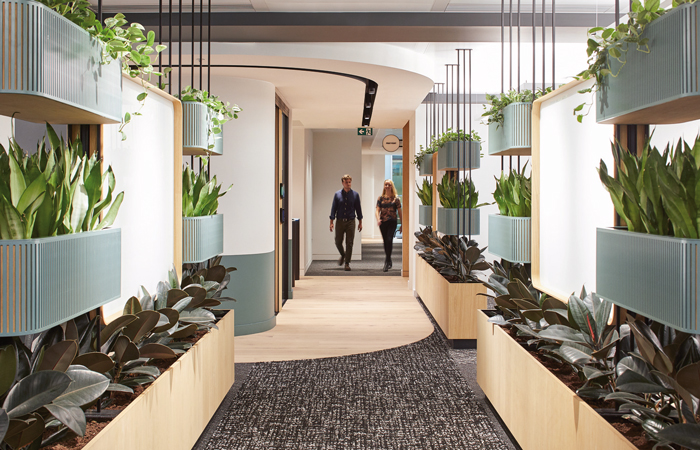
HLW, Ninety One London ©Hufton Crow
One of your most recent initiatives is the launch of a Healthy Material Protocol, a new, critical resource that ensures that the practice’s architects and designers have knowledge of and access to healthy and sustainable building materials. This sounds extremely exciting, could you introduce the project in more detail and explain what research it encompassed?
The Healthy Materials Protocol came about due to a variety of factors. It was partially inspired by our AIA 2030 pledge, partially because we have BEYOND – our own team of sustainability analysts and embodied carbon experts – and partially because we work with some of the biggest tech giants who were early adopters of this approach to material selection. We had been working on projects with goals for ‘healthy materials’ since 2018 and within the business there was more and more talk about implementing this on other projects. Naturally this was starting to happen as designers learned more about the impact of the materials we were specifying and led them to make better choices. The Protocol itself was 2+ years in the making after the launch of our Sustainability Action Plan. A multi-disciplinary group from across all HLW offices came together to establish our baseline criteria, our evaluation techniques, and how we would roll this out across our firm. It was no mean feat to set criteria that would work globally in EMEA as well as the Americas! It was crucial to this group that the protocol be something that could be understood and implemented by all our specifiers, and that the baseline we set would be one that was inclusive of small manufacturers not just the big-name brands who could afford to certify their products multiple times over. We spent a long time debating the merits of different rating systems before establishing our goal and the story we wanted to tell. We are incredibly proud of what we accomplished together. Our Healthy materials protocol encourages positive change and rewards it rather than berates imperfection. It allows innovative, new materials to be specified to help drive demand for something better. Our biggest hurdle was re-stocking and assessing our libraries across our various offices! The protocol is not fixed, and we are already looking at version 2.0 so we can keep improving and pushing it forward.
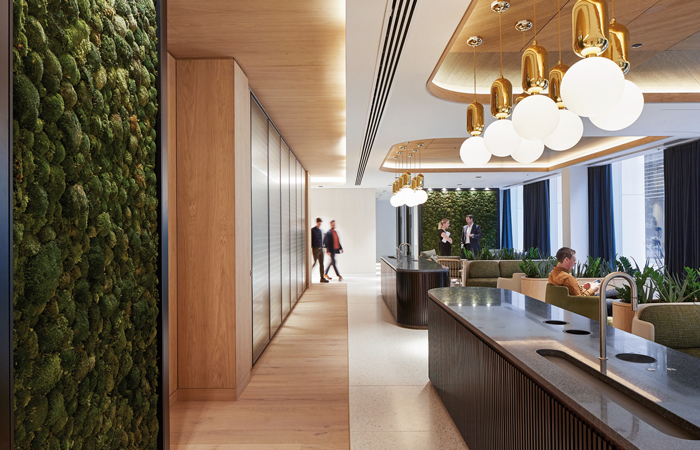
HLW, Ninety One London ©Hufton Crow
The Healthy Material Protocol is a staggering feat, what does this mean for your practise and your clients?
It means that every project that comes out of any of our studios, as a baseline, considers the health and wellbeing of the occupants of that space. This in turn, because of the criteria we have set, means that the project will be more environmentally friendly than it might have otherwise been.
It means that every client, whether they want to or not, is making a better impact on people and the environment, and yes there are still clients out there who say they don’t care about the environment.
It means that, as a practice, we are taking our responsibility as a trusted advisor seriously. We are not just responding to a client’s brief, but we are doing what we believe to be our ‘bit’ to foster the health of those using the spaces we design and contribute towards reducing the environmental impact of the construction industry.
As a bonus, our clients get a strong story to tell their staff and visitors about how they in turn care, because they worked with HLW. We are regularly speaking with project steering groups about how to retain and attract staff in this post-COVID world and one of the strongest ways to do this is by having a strong ESG message which the healthy materials protocol supports. Wouldn’t you prefer to work for an organisation who care about their staff enough to consider the potentially harmful effects of elements in their building where you spent at least 8 hours a day, over one who didn’t? COVID taught us the value of human health (both mental and physical) more than anything and this narrative is aligned with our decision to not just focus on sustainable materials, but materials that will have no detrimental impact on health.
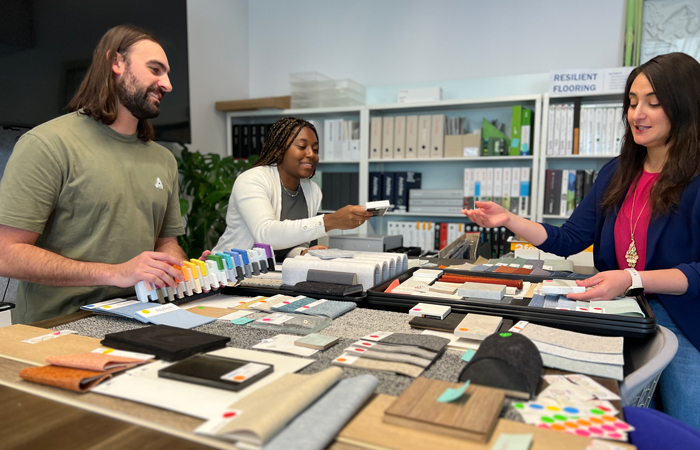
HLW, Materials Library
Your role in the launch of the Healthy Material Protocol included developing the protocol with your NYC office, what did this collaboration look like and what were your highlights?
Collaborating with our colleagues across the pond is always exciting and I’ve been lucky enough to have built up a great relationship with my counterparts in our New York, New Jersey, and California offices as well as our sustainability consultancy BEYOND. I had been working with Emmy Funk, a brilliant sustainability analyst from BEYOND, on several projects for one of our tech clients. Emmy and I were always impressed by how much this client was willing to push sustainability up their agenda. Taking inspiration from this I began implementing elements I was learning from those projects with regards to material health on other projects within the London office. At the same time, unbeknownst to me, the teams in the US were revitalising a long-term project to clean up our specifications and libraries. Being the gobby sort of person I am I was keen to get involved with this and ensure London didn’t miss out on this exciting initiative. We were in lockdown at the time, so remote meetings were standard. Every Friday at 5pm GMT a representative from each office plus our BEYOND and Material Technology expert teams got together to discuss how we might implement this, how we would set criteria for scoring products, and how we would collate data. My role was to ensure whatever was agreed could translate to the UK/EMEA market as well as for our larger US market. It was crucial to ensure we didn’t come up with a strategy that couldn’t easily be implemented by our UK design team. It was important to us that our Healthy Materials Protocol could be easily interpreted by our teams, easily aligned with our projects, and easily bought-into by our clients. So, the solution had to be truly global, which it wouldn’t have been without London’s involvement.
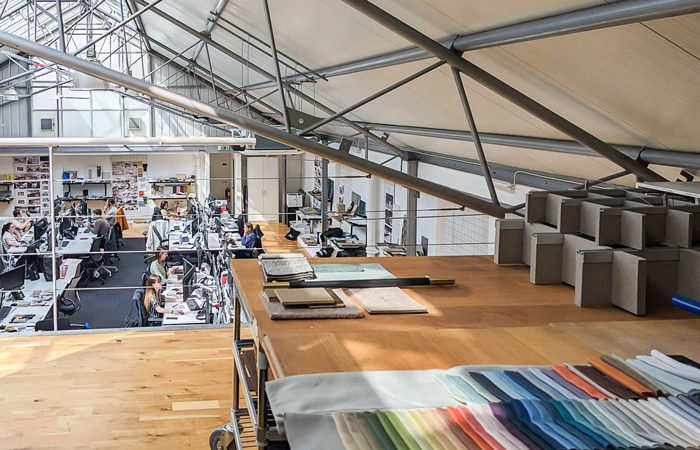
HLW, Materials Library
The neurodiverse girl in me will tell you that getting to grips with all the materials data, discussing pros and cons of setting certain criteria, and truly understanding material health was the highlight for me. I am very detail orientated and rarely do I find a forum where I can go into the depths of research and understanding on a topic that satisfies my brain, but working with a small group of incredibly talented and knowledgeable individuals towards a common goal was absolutely exhilarating. Our team was made up of project managers, interior designers, sustainability analysts, architects, and specifications experts – bringing all those together was what resulted in such a succinct, practical solution.
The final questions in our interviews often focus on the future and I feel that it is particularly important within this conversation for me to position this question in relation to the need for change. You are passionate that workplace sector needs to change, what drives you to be part of the revolution and what imminent/or long-term change would you hope for us to see?
I’ve always been passionate about environmental concerns. I was brought up by parents who protested regularly and still do in their retirement.
Recent world events like the COVID pandemic and the Russian invasion of Ukraine took the world’s focus off our climate change goals and have spurred me to want to help our industry to make bigger changes, sooner. I would love to see every architectural practice adopt a stance on material selection that benefits the environment regardless of the project’s sustainability goals. I’d also love to see manufacturers taking heed and making the changes we are asking for, removing harmful chemicals from their supply chains, and taking steps to significantly reduce their carbon emissions (both operational and embodied). I would love to see a less wasteful industry with more emphasis on quality, longevity, and circularity than trends, new collections, and trade shows.

HLW, Natural Materials Palette
In an ideal world I’d love to see donor schemes set up in all major cities, where end-of-life projects can feed new ones with repositories of construction materials, FFE and building services systems available at a level that would meet demand in a realistic and commercially viable way. This would vastly reduce the amount of waste produced from virgin materials being mined and new products being manufactured.




